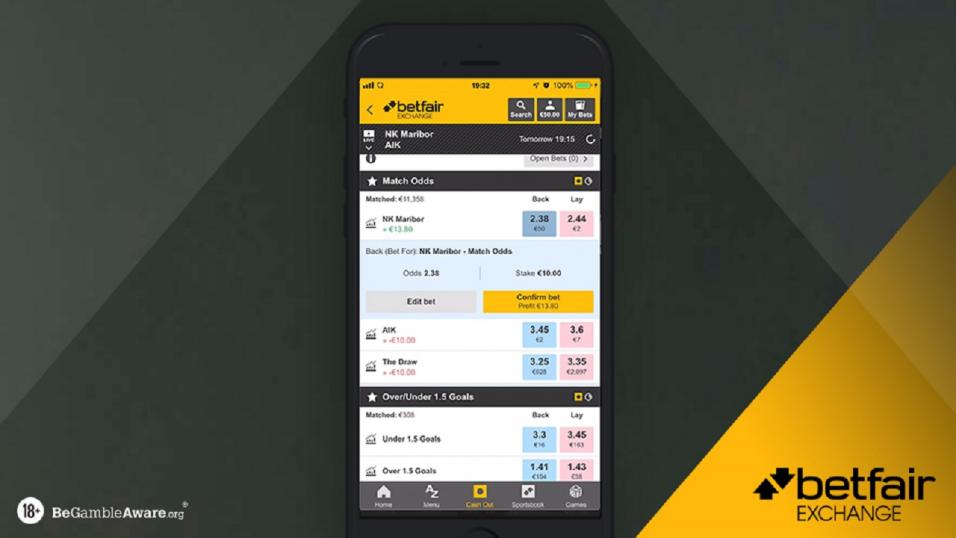Back-to-Lay and Lay-to-Back

'Back-to-Lay' betting is a technique whereby the bettor will place a bet on a selection at high odds, and look to lay the same selection at a lower price on an exchange platform such as the Betfair Exchange. In doing so, once the lay element of the bet has been matched, the bettor has locked in a profit regardless of the eventual outcome.
Flipping this technique around, the bettor can also make use of the 'Lay-to-Back' betting method, and in this situation the bettor will look to lay a selection on an Exchange platform at an agreed set of odds, before then going on to back that same selection either closer to the start time of the event, or in-running/in-play. The variation in odds will hopefully secure a profit, again before the event is completed.
One of the key advantages of the Betfair Exchange is that it allows bettors to create a position in a market where they can profit from several, or even all outcomes. Although we’ve already discussed easy ways you can do this in our guide to Auto and Partial Cash Out, experienced Exchange users can take this to a more advanced level, and open up chances for further profit, with 'back-to-lay' and 'lay-to-back' tactics.
Use the Betfair Exchange to guarantee profit
If you’ve placed a bet on the Exchange, you’ll then see there’s a green or a red value next to every selection in that market, whether you’ve placed a bet on that selection or not. The value indicates how much money you stand to make – displayed in green – or to lose – displayed in red– should the corresponding selection win.
Meanwhile, because every selection has some bearing on whether, and how much, you stand to win or lose, your position on them all collectively is known as your ‘book’ (this in turn explains where the term ‘bookmaker’ comes from).
Therefore, by getting yourself into a position where you don’t stand to lose on any outcome, you’ve created what’s known as a ‘green book’.
So how do we as Exchange bettors get ourselves into such a desirable position?
The short answer is that we need to adjust our position in a market as it develops, so that we lay bets at shorter prices than we then back them at, or back at bigger prices than we then lay them at. All of the following techniques work to the same fundamental principle: removing your risk by betting tactically on alternative outcomes, to create more scenarios where you win. And don’t forget – you can keep on adjusting your position all the time until the event comes to a close. The more you watch of the event and the more twists and turns there are, the greater the opportunity to trade yourself into an even better position.
Back-to-lay betting: the basics
Two-runner markets usual occur in in head-to-head sports where a result cannot be tied – like tennis, darts (in knockout tournaments) or snooker. But whilst two-runner horse races are comparatively rare in the UK and Ireland, this is probably the simplest way to start explaining lay-to-back and back-to-lay, so we’ll look at this scenario first.
Altior and Cyrname are racing over 2m 2f on soft ground. The horses are closely matched, one with a speed advantage and the other with a stamina advantage, so tactics and pace will be decisive. The market has Altior at 1.50 and Cyrname at 3.0. Let’s say you back Cyrname for £20, which will return £60 if he wins, £40 of which will be profit. The outcomes in your ‘book’ are as follows:
Scenario 1 (start of race)
Outcome A: Cyrname wins = £40 profit
Outcome B: Altior wins = -£20 loss
*For all the examples in green, you would minus a small percentage in commission on any pay-out you receive
The race begins, and as predicted (you can see pace predictions for every race with the Timeform Pace Maps) Cyrname goes in front to force a strong pace. His price begins to shorten – essentially because he’s in the better position of the two (this is in fact a very popular form of back-to-lay betting on the Exchange, as you can reliably expect front-runners’ odds to decrease in-play).
However. Let’s say that with a few fences to go and Cyrname still leading, Altior stumbles upon landing and falls a few more lengths behind. In-play betting now sees Cyrname trade at 1.50 himself, whilst the lay market is trading at 1.51. Essentially, this means two more options have now opened up for you.
Remember: you know you already stand to win £40 profit if Cyrname wins, which means you have the opportunity to stake anything up to £40 on the opposite outcome if you want to, whilst still guaranteeing overall profit thanks to your original bet. This is called ‘laying off’ your liability. This means you now have an opportunity to come away with a profit regardless of the result – and where the technique of back-to-lay can come in.
Firstly, you could lay off your potential losses by backing Cyrname not to win. In this instance, because there are only two horses, this would most likely require Altior to win (although it also includes the possibility that neither horse completes the race and there is no winner).
At this point, it’s important to point out that for reasons that are helpful to this method, the lay column does not work like the back column (although you can change this in settings): instead of clicking a price and entering the amount you want to stake, you click the price and enter the amount you want to win. Therefore, to neutralise your potential losses and win back a £20 return on this lay bet (minus commission), you would need to stake £10.20 (you can check what odds give what profit, for what liability, with Betfair’s Lay Bet Calculator).
Scenario 2 (in-play)
Outcome A: Cyrname wins = £43.13 profit [as in Scenario 1, minus £10.20 lay bet lost]
Outcome B: Altior wins = £00.00 profit [£20 loss from original stake, plus a £20.00 return from the lay bet]
You now have a green book. However, you also have the option not just to lay off your potential losses on Cyrname, but instead to choose to try to win money on Altior. In other words, not only can you lock in a profit if the odds move in your favour, you can also change your mind and go for a still-bigger win.
We can illustrate when you might want to do this with our example. Let’s say, despite the bad stumble, you’re suspecting Cyrname’s rider has not gone fast enough to counteract Altior’s acceleration in the finish, and with energy to spare for the run-in, you think he can still make up the distance lost.
Therefore, knowing you have that £40 profit in the bank to play with, you instead decide to use £30 of it to lay Cyrname at 1.51 – enough not just to cancel your losses if Altior wins, but to make a profit on that too, if he does.
Scenario 3
Outcome A: Cyrname wins = £10 profit [as in Scenario 1, minus £30 lay bet lost]
Outcome B: Altior wins = £38.82 profit [£20 loss from original stake, plus £58.82 profit from the lay bet]
How lay-to-back betting works
The fundamentals of lay-to-back are pretty much exactly the same as back-to-lay, only the opposite way around. For example, you might have reason to believe, perhaps based on Timeform’s Early Position Figures or similar data, that a horse’s odds will lengthen during running.
Let’s say it’s about to go off favourite, but you know the pace is likely to be strong and the horse is usually held up at the rear of the field. You could lay the horse pre-race – ensuring a comparatively long lay price – and if the prediction is correct and it settles at the rear, then back it in-running at what would likely be a longer price than its BSP was, to lock in profit either way. The downside to this tactic is that, if the horse doesn’t drift in-running and goes on to win, then you lose the liability for your lay bet. Lay-to-back carries this danger whereas back-to-lay doesn’t really, due to lay odds generally being so much shorter than back odds in multi-runner markets. So, although which one you choose depends on what you think will happen during a race, and how the market will react, you need to be confident in your selections.
The principle is the same; how much you want to wager on either outcome is up to you. You can either play shrewd and hedge your bets completely for small profits all-round, or if you have a strong opinion on which outcome will prevail, alter your book so that you stand to win more if you get it right. It’s always a question of timing your bets right – buying low and selling high.
Using back-to-lay in multi-runner markets
The two-runner market is by far the simplest way of securing a green book, as bettors only have to worry about two outcomes. But if you’re comfortable with how the Exchange works, it’s possible to build a green book for a multi-runner race. After all, that’s essentially how most bookmakers work – only they’re in charge of all the odds in a market, so they can fix them in their own favour. In a nutshell, this is the reason why the Exchange gives you the best prices.
The main difference with a multi-runner race is that given the increased number of outcomes, the more you must split your potential winnings between your book, in order to cover all eventualities. Again though – how heavily weighted your risk and reward is towards individual horses is your decision, so it might be that you accept a break-even on most of the runners, in order to maximise potential profit on the horse you think will actually win. Or perhaps even on a favourite you think will lose. The thing to remember about the Betfair Exchange is that there are many ways to win – you don’t ever have to pick a race winner in order to profit, just anticipate what the market will do. And products like Timeform Race Passes can help you find more opportunities to profit, in more ways.
Let Betfair do the work
Whilst the basics of the Exchange are very easy to learn, it does take some more understanding to become proficient at using back-to-lay and lay-to-back tactics. Though as you have read – it is well worth the practice if you want to improve your betting and expand your opportunities to make profit.
Still too much computing involved? If don’t feel confident enough with the numbers yet, you can always use the Betfair Exchange’s Cash Out features to settle your bet before the event has finished – either by doing it manually or setting an Auto Cash Out value to automatically end the trade once you achieve a certain level of profit. There’s even a Partial Cash Out option, so you can take a portion of money out of a trade, whilst leaving the rest to ride. You can learn more about these options, here.















